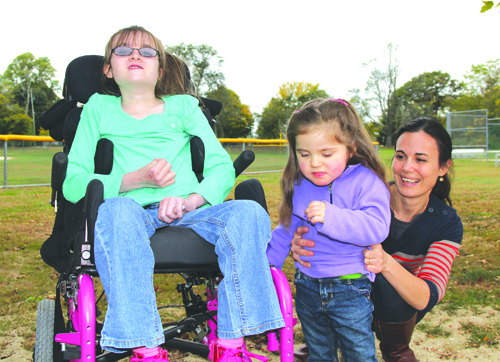Families of kids with Rett syndrome hope for cure

Looking at 2-year-old Maren DeSantis of Mattituck, you notice a depth to her gaze as she concentrates on the faces of those around her.
The brown-eyed, brown-haired toddler seems calmer than most her age, as she sits quietly in her mother Lena’s lap, fiddling with her fingers.
Just six months ago, Maren was diagnosed with Rett syndrome, a neurological disorder that will eventually strip her of the ability to walk, talk and use her hands or mouth.
What is both “amazing and heartbreaking” about Rett, said Lena DeSantis, is that those afflicted maintain their cognitive function — “it is almost like they are trapped in their bodies,” she said.
Maren is one of two young girls on the North Fork who have been diagnosed with Rett syndrome. Rachel Garms of Southold, now 11, was Maren’s age when she was first diagnosed with Rett — around the same time genetic testing for the disorder first became available. Now in seventh grade, she is confined to a wheelchair, but is as present and perceptive as any other soon-to-be-12-year-old.
The girls had the opportunity to meet for the first time this past weekend at Tasker Park in Peconic, where Maren sat on a swing — with her mother’s help — while Rachel looked on knowingly.
Rett syndrome is as prevalent as cystic fibrosis, Huntington’s and ALS, which are better known. It is vastly underfunded compared to those disorders, according to the Rett Syndrome Research Trust, which seeks to raise research funding.
Researchers discovered in 1999 that it is caused by mutations in a gene on the X chromosome known as MECP2, which produces proteins critical for normal brain function.
Because it is an X-linked disorder, Rett affects girls almost exclusively. Girls diagnosed with Rett are often called “silent angels,” as they quietly see all that is going on around them.
Rett affects an estimated one in 10,000 females and is not an inherited disorder, according to the National Institutes of Health.
Like Rachel and Maren, those with the Rett mutation usually have six to 18 months of what seems like normal development before signs of the disorder begin to emerge. They can also suffer from seizures and scoliosis — complicating its already challenging effects.
To help develop her cognitive skills, Maren is involved in an early intervention program that provides special education, speech therapy, physical therapy and occupational therapy as many as five times per week, Ms. DeSantis said.
Rachel benefits from a one-on-one aide and participates in speech therapy, physical therapy and occupational therapy, which she gets through the Southold school district, according to her father, Steve Garms.
Aided by new tools, girls with Rett may eventually be able to communicate, said Monica Coenraads, executive director of Rett Syndrome Research Trust. Ms. Coenraads, who lives in Connecticut, also has a 17-year-old daughter, Chelsea, with Rett syndrome.
Using what’s called eye-gaze technology, the girls make eye contact with different options on a computer screen, visually choosing a letter or word. The specific option lights up when a connection is established. With enough concentration, users can construct full sentences, but the time and patience needed by all involved can be daunting, Ms. Coenraads said.
“Chelsea has an opportunity to communicate with us in a way for the first time ever. In some respects we know her so well, but we’re also getting to know a different side of her,” she said.
Both Maren and Rachel are starting to incorporate the technology in the their day-to-day intervention. While Maren is just old enough to start using it, Rachel has been using an iPad program to help her learn in the classroom.
“It’s a disorder that’s exciting and challenging, and there’s a lot of interest from the scientific community,” Ms. Coenraads said.
While science has not been able to pinpoint the genes causing other neurological disorders, such as autism and Parkinson’s, they have in Rett, making it “a fairly high-profile disorder,” she said.
In 2007 — using a mice model — scientists were able to show that when levels of the protein produced by healthy MECP2 genes were restored, symptoms seemed to disappear, Ms. DeSantis said.
In September, scientists were able to show brain function could be restored in female mice by replacing the mutated gene with a healthy version of the gene, according to a Toronto Western Research Institute study.
“I really believe that science might cure Rett,” Ms. DeSantis said. “If it happens when she’s, say, 15, she has tons of potential.”
Mr. Garms said he is confident a cure is in Rachel’s future and is looking forward to the day she can walk across the stage to pick up her high school diploma.
“These girls will have some story to tell,” Ms. Coenraads said.


